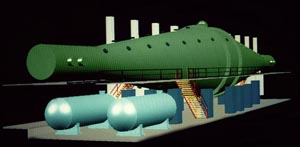One of the world’s biggest van de Graaff electrostatic accelerators is to be shut down amidst protests from European nuclear physicists. The two-million-volt Vivitron facility in Strasbourg, France, is set to close even though researchers point out that the successor to this technology is yet to be built.
France’s National Institute of Nuclear and Particle Physics made the decision to close the Vivitron purely for financial reasons. According to a report in the journal Nature, the move to close the facility will drive some exotic nuclear researchers out of the field for good.

The Vivitron facility
The fundamental physics of exotic nuclei, those atomic nuclei whose proton and neutron counts are wildly different from the more common stable nuclei, is a highly energetic research field worldwide. There are, however, many unanswered questions in the field about how protons and neutrons interact that continue to challenge nuclear physicists. Research at the Vivitron facility into exotic nuclei has been at the heart of understanding everything from the stellar synthesis of the chemical elements to our fundamental models of the universe and the forces that hold it together.
Two technical hiccups in the 1990s saw the facility shut down temporarily in 1991 and 1995. The first incident followed pollution with hydrofluoric acid accidentally produced in the sulphur hexafluoride gas drying towers, which led to a 12 month closure. The second involved problems with the suppliers of a new rubber-coated fabric belt which closed the facility for eight months. Despite these setbacks, the Vivitron continued to spark scientific interest.
However, there has been a move away from accelerators of this kind in recent years to carrying out exotic nuclear research with radioactive ions. Marielle Chartier, on leave from the University of Bordeaux, is a lecturer at the University of Liverpool, began an EPSRC Advanced Fellowship in October 2001, and is at the forefront of radioactive beam research.
The predictive power of nuclear models developed for stable nuclei will be greatly improved by extending mass measurements to the most exotic nuclei, explains Chartier. It is radioactive ion beams that are thought to be the best bet for generating the essential data for understanding nuclear physics but facilities based on this concept are still in their infancy or, more to the point, yet to be built.
There are hundreds of Vivitron users outside France who, according to Nature, are planning to challenge the closure. One point of contention is that there are many PhD students working on projects that rely on data from the facility.
Further reading
Suggested searches
Exotic nuclei
Radioactive ion beams
Particle accelerators
van de Graaff electrostatic accelerators